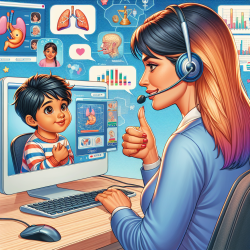Introduction
In the field of speech-language pathology, especially when working with children, understanding the underlying personality traits can be crucial for tailoring effective interventions. The recent study, "Harmonization of Neuroticism and Extraversion phenotypes across inventories and cohorts in the Genetics of Personality Consortium: an application of Item Response Theory," provides insights that can be pivotal for practitioners aiming to improve their skills and outcomes.
Understanding the Research
The study applies Item Response Theory (IRT) to harmonize personality traits like Neuroticism and Extraversion across different inventories and cohorts. This approach ensures that data from various assessments can be compared on a common scale, enhancing the reliability and validity of the findings. With data from over 160,000 individuals across 23 cohorts, the study demonstrates the effectiveness of IRT in achieving measurement invariance, particularly when cohorts share the same language.
Implications for Practitioners
For speech-language pathologists, especially those involved in online therapy services like TinyEYE, understanding the personality traits of children can significantly impact the design and delivery of therapy. Here’s how practitioners can leverage the outcomes of this research:
- Enhanced Assessment: By using IRT-based assessments, practitioners can ensure that the personality traits of children are measured consistently, irrespective of the inventory used.
- Tailored Interventions: Understanding a child's level of Neuroticism or Extraversion can help tailor interventions that align with their personality, potentially increasing the efficacy of therapy.
- Data-Driven Decisions: The harmonized data allows for more robust data-driven decisions, enabling practitioners to track progress and adjust interventions based on reliable data.
Encouraging Further Research
While the study provides a robust framework for harmonizing personality assessments, it also opens avenues for further research. Practitioners are encouraged to explore how these harmonized measures can be integrated into existing assessment protocols and to investigate the impact of personality traits on therapy outcomes. Collaboration with researchers to further refine these measures and apply them to specific populations could lead to even more tailored and effective interventions.
Conclusion
The application of IRT in harmonizing personality traits offers a powerful tool for speech-language pathologists. By integrating these insights into practice, practitioners can enhance the precision and effectiveness of their interventions, ultimately leading to better outcomes for children.
To read the original research paper, please follow this link: Harmonization of Neuroticism and Extraversion phenotypes across inventories and cohorts in the Genetics of Personality Consortium: an application of Item Response Theory.










